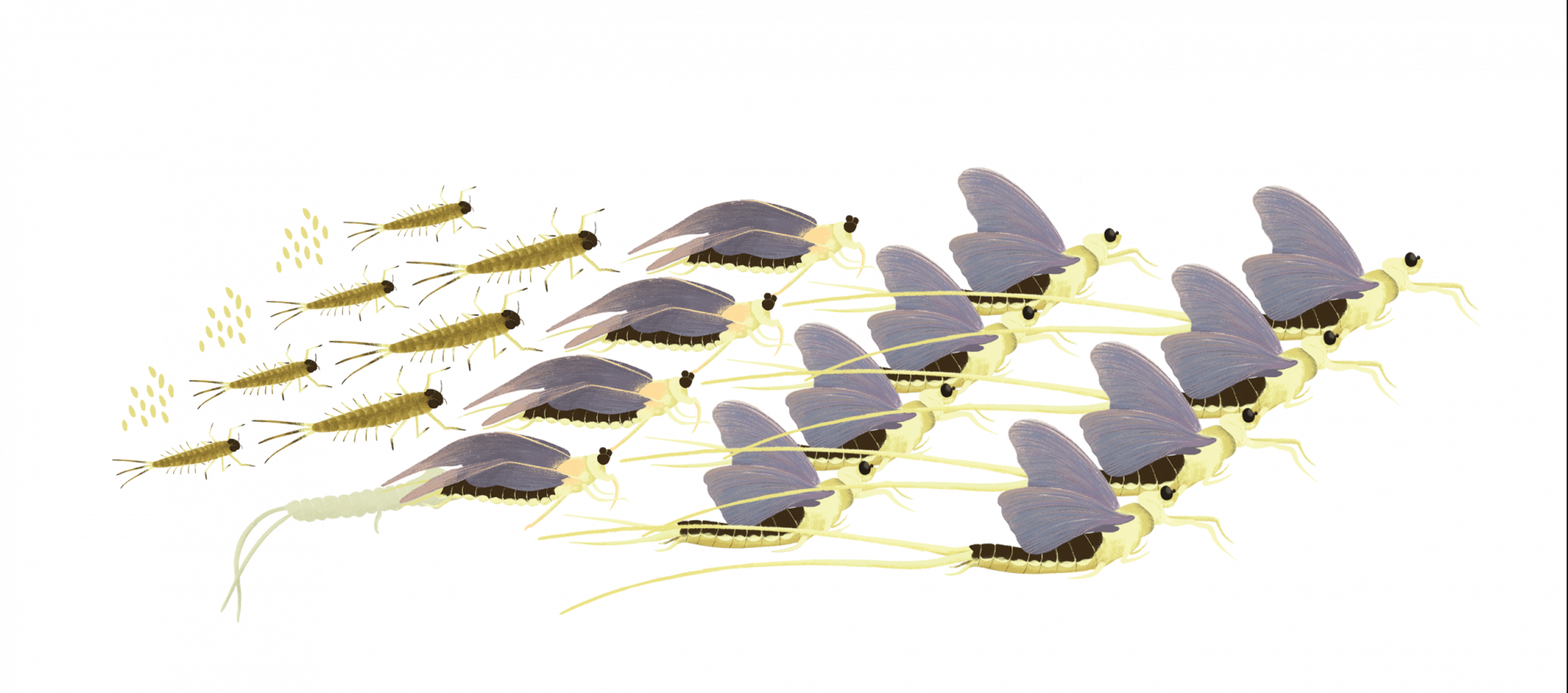Millions of 10-cm-long yellow insects emerge from the river and scramble onto the water surface to mate. Then, these little beauties fly ‘en masse’ upriver for several kilometres to lay eggs, all in a span of 2-3 hours on a calm early-summer evening. To people fortunate to catch it, this will always be a wondrous, peculiar phenomenon. This is the spectacular swarming of the long-tailed mayfly (Palingenia longicauda), a species in the insect order Ephemeroptera.
In the past, the long-tailed mayfly was common in middle sections of lowland rivers all over Europe. The species is now confined to the catchment (an area of water collection and drainage) of the river Tisza in eastern Hungary, the Rába river in western Hungary, the Prut river in Moldova, and some other rivers in Ukraine.
Somewhere, this confinement is a tragedy. What happened to this spectacular mayfly, whose swarming was first documented as early as 1634 in north-west Europe? Recent studies show that the species has lost more than 95 percent of its geographical range in a few centuries. It went extinct in France in 1922, Germany in 1953, and disappeared from Danube, the largest river in central Europe, in 1974.
Causes of loss
The most likely reasons for this loss are river regulation, riverbank modifications such as riprap stone structures, and water pollution. The larvae of this species live in burrows that are dug in eroding clay riverbanks underwater. They undergo 20 moults (the process of shedding skin, feather etc.) during their three-year development period. They come above the water surface to become imagoes — sexually mature adult insects post metamorphosis — in a final moult, reproduce and die, all within a few hours.
Eroding clay riverbanks typically form on the outer arches of river bends, and the progression of erosion often threatens densely populated human settlements or agricultural areas in Europe. As a result, structures to prevent erosion were built by water management agencies. But this led to the disappearance of the classic habitat of Palingenia mayflies in many river systems. The larvae feed by filtering organic matter and algae from the water moving through their burrow and serve as an important food base for a variety of fish. Water pollution further exacerbates the effect of habitat loss, and the decline of this larvae also threatens higher trophic levels along the food web.

New threats
The mayflies, however, had found their fortune in traditionally “unfortunate” countries in Eastern Europe, where rivers were more or less left alone. However, new developments threaten even the remaining range of the species. The unpredictability of water supply and long periods of drought increasing with frequency under climate change are resulting in an absence of the spring and early-summer floods that once rejuvenated the eroding clay riverbanks. As a result, sediment was deposited in the outer arches of riverbanks. This prevented the larvae from digging their burrows in the riverbank.
Another recent threat is that swarming often occurs now over several days, rather than on one “big day”. When there are fewer individuals swarming over several days, predators can catch more of them proportionally than they would during one big, swooping swarming. If predators are able to take, say, 50,000 individual mayflies per day, a swarming of 1 million mayflies distributed over 10 days will leave half a million mayflies to reproduce. But if the swarming occurs on one day, this number will be 950,000. This is a huge difference in the number of individual mayflies reproducing in the population. These processes may explain recent observations that the number of individual mayfly swarming has declined in many sections of the Tisza.
A chance for the mayflies
While the mayfly swarming has long been a celebrated local event along the rivers where it is still found, large-scale conservation attention has evaded this species. For example, the species is not listed in the Habitats Directive, the cornerstone of non-bird species conservation in the European Union. However, the recent listing of the mayflies and their spectacular swarming as a “hungaricum” (worthy of distinction unique to the country of Hungary), may change this. We expect increased attention to the species and its declining conservation status.
There is reason to hope that water management interventions that damage classic habitats will not be implemented. In areas where this is possible, restoration of the mayflies’ habitats by removing riprap and other stone structures will also become necessary. However, larger-scale thinking and coordination are necessary to ensure the long-term persistence of the species. We need to preserve or restore natural and semi-natural habitats, mainly forests, in the upstream areas of the catchment to reduce the unpredictability in water discharge. All this requires trans-boundary cooperation between the countries sharing the Tisza catchment area. Such cooperation has proven successful in alleviating the effects of river pollution recently. We need similar, consistent efforts of cooperation to address the threats to the mayfly – the hidden beauty of many meandering rivers.






